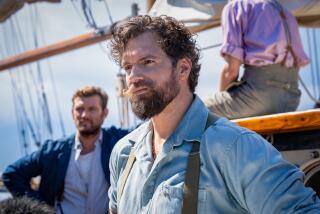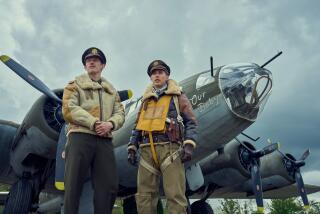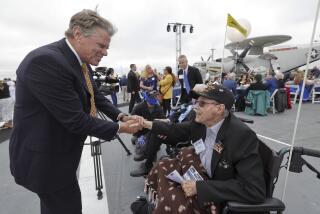Busy Seabees Stay True to the Duke’s Film
CAMP 93, Kuwait — Gone these 23 years, John Wayne still inspires Navy Seabees.
The Seabees were the heroes of one of the most famous war movies: 1944’s “The Fighting Seabees,” starring Wayne and Susan Hayward. It is the story of how the military, after the fall of Wake Island, formed a construction battalion (hence the name Seabees, from CB) that could fight as well as build.
The film illustrates the unit’s motto: Can do. Now the real Seabees have come here to play their role if there is a war with Iraq.
Using this sprawling desert camp in northern Kuwait as a headquarters, construction battalion sailors from Port Hueneme in Ventura County; Gulfport, Miss.; and Pearl Harbor, Hawaii, have built a complex network of runways, aircraft parking areas, and maintenance and fueling facilities for hundreds of U.S. and British aircraft.
Maj. Gen. James F. Amos, commander of the 3rd Marine Aircraft Wing, headquartered at Miramar Marine Corps Air Station in San Diego, visited the Seabees last week to express his thanks.
“I don’t think we’d be able to do what we may be called upon to do had the Seabees not been here,” Amos said.
Among the Seabee projects was a massive storage facility for aviation munitions. “We’re going to have more aviation ordnance stored here than anywhere at any location since Vietnam,” Amos said.
With the aviation-linked projects completed, the Seabees are now sharpening their bridge-building skills in case the Marines need to traverse the rivers and ravines that crisscross the landscape between the Kuwaiti border and Baghdad.
“The Seabees took Patton across the Rhine,” said Rear Adm. Charles R. Kubic, the bear-sized engineer who commands the 1st Marine Expeditionary Force Engineer Group, which also includes Seabee reservists and Army and Marine Corps troops.
Now, if Marines from Camp Pendleton are assigned to race to the Iraqi capital, chances are they will travel over bridges and roads built by the Seabees.
Formed early in World War II, the Seabees keep combat troops from being thwarted by bad roads, impassable rivers and other environmental obstacles. But their spirit is cinematic.
A large-screen showing of the Wayne movie a few nights ago drew a standing-room-only crowd in one of the large tents where the Seabees sleep, eat and relax. A second showing was ordered to accommodate the overflow.
For most in the audience, it was not their first viewing. “The Fighting Seabees” is required viewing at the training school for Navy engineers.
Capt. David L. Fleisch, commander of the Port Hueneme battalion, likes to quiz his troops about “The Fighting Seabees.”
What was the name of the John Wayne character? (Wedge Donovan.) What was the name of the bulldozer he was driving when he died gloriously in battle? (Natasha.)
For reporters unaware of the Seabees’ history, Kubic recommended -- you guessed it -- “The Fighting Seabees.”
“That’s how it really happened,” he said.
Fleisch also likes the scene in “Saving Private Ryan” where a Seabee tells troops landing on D-Day to keep moving because the Seabees are coming through. But his heart belongs to Wayne’s film.
“At home, I have it on both DVD and video,” Fleisch said.
While many construction methods have changed since “The Fighting Seabees” was filmed at Port Hueneme, Point Mugu and Camp Pendleton, some things remain the same: the need to complete projects quickly (bridge construction is measured in hours) and build in often inhospitable locales.
In Kuwait, Seabees have had to overcome the powdery sand, relentless wind and occasional rainstorm.
“Most people don’t expect rain in the desert,” Fleisch said. “This ground looks fairly friendly. But when it gets wet, it turns into peanut butter.”
The Seabees have been here since fall, under a cloak of secrecy. The locations of their various projects are classified and the number of Seabees on the ground is a secret, but the results of their work can be seen.
Marine Corps helicopters and F/A-18 Hornets were overhead last week. Both can land at airstrips built by the Seabees. The Marines’ Harrier vertical-lift attack planes and various categories of British aircraft are also using the new strips.
Camp 93 is named for United Airlines Flight 93, one of four airliners hijacked by terrorists on Sept. 11. Passengers on Flight 93 fought back and possibly kept the terrorists from crashing the aircraft into the White House.
One of the passengers was heard to exhort his fellows with the order “Let’s Roll.” His words now adorn the heavily guarded entryway to Camp 93.
Each Seabee is required to wear a flak jacket and keep a gas mask at the ready -- even when lifting heavy sections of a portable bridge that may someday span an Iraqi river.
“It’s for my country,” said Petty Officer 3rd Class Alexander Sanchez from Port Hueneme.
The Duke would have understood.


